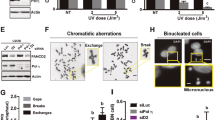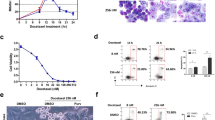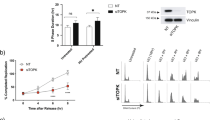Abstract
There is an ongoing controversy regarding the relevance of apoptosis induction by ionizing irradiation as compared with other end points including transient or permanent cell cycle arrest of damaged cells. Here, we show that such permanent cell cycle arrest and apoptosis represent two sides of the same coin. MCF-7 cells fail to express procaspase-3, which results in resistance to apoptosis induced by anticancer drugs. Conversely, restoration of procaspase-3 sensitizes MCF-7 cells to chemotherapeutics including epirubicine, etoposide and taxol. In contrast, irradiation does not trigger apoptotic cell death but results in prolonged arrest in the G2 phase of the cell division cycle regardless of procaspase-3 expression. This suggested that the propensity of MCF-7 cells to arrest at the G2 checkpoint results in resistance to apoptosis upon γ-irradiation. This G2 arrest was associated with upregulation of p21CIP/WAF-1. Inhibition of DNA-damage-induced stress kinases and p21CIP/WAF-1 expression by caffeine abrogated G2 arrest and induced apoptosis of the irradiated cells in a caspase-3-dependent manner. Inhibition of cell cycle progression by adenoviral expression of the cyclin dependent kinase inhibitor p21CIP/WAF-1 prevented apoptosis upon caffeine treatment indicating that cell cycle progression, that is, G2-release, is required for induction of apoptosis. Likewise, cells homozygously deleted for p21CIP/WAF-1 (HCT116 p21−/−) display enhanced irradiation-induced apoptosis via a caspase-3-dependent mechanism. These data indicate that the disruption of G2 checkpoint control overcomes cell cycle arrest and resistance to γ-irradiation-induced cell death. Thus, DNA damage may trigger a permanent G2 arrest as an initial inactivation step of tumor cells where the phenomenon of apoptosis is hidden unless cell cycle arrest is overcome. The efficient induction of apoptosis upon G2 release thereby depends on the propensity to activate the key executioner caspase-3. This finding is of crucial importance for the understanding of molecular steps underlying the efficacy of ionizing radiation to delete tumor cells.
This is a preview of subscription content, access via your institution
Access options
Subscribe to this journal
Receive 50 print issues and online access
$259.00 per year
only $5.18 per issue
Buy this article
- Purchase on Springer Link
- Instant access to full article PDF
Prices may be subject to local taxes which are calculated during checkout








Similar content being viewed by others
References
Bhonde M, Hanski ML, Magrini R, Moorthy D, Müller A, Sausville EA et al. (2005). Oncogene 24: 148–156.
Bunz F, Dutriaux A, Lengauer C, Waldman T, Zhou S, Brown JP et al. (1998). Science 282: 1497–1501.
Chan TA, Hermeking H, Lengauer C, Kinzler KW, Vogelstein B . (1999). Nature 401: 616–620.
Chartier C, Degryse E, Gantzer M, Dieterle A, Pavirani A, Mehtali M . (1996). J Virol 70: 4805–4810.
Chu K, Teele N, Dewey MW, Albright N, Dewey WC . (2004). Radiat Res 162: 270–286.
Daniel PT, Sturm I, Ritschel S, Friedrich K, Dörken B, Bendzko P et al. (1999). Anal Biochem 266: 110–115.
el-Deiry WS, Tokino T, Velculescu VE, Levy DB, Parsons R, Trent JM et al. (1993). Cell 75: 817–825.
Essmann F, Wieder T, Otto A, Muller EC, Dörken B, Daniel PT . (2000). Biochem J 346(Part 3): 777–783.
Friedrich K, Wieder T, von Haefen C, Radetzki S, Schulze-Osthoff K, Jänicke R et al. (2001). Oncogene 20: 2749–2760.
Gillissen B, Essmann F, Graupner V, Stärck L, Radetzki S, Dörken B et al. (2003). EMBOJ 22: 3580–3590.
Güner D, Belka C, Daniel PT . (2003). Curr Med Chem – Anti-Cancer Agents 3: 319–326.
Hasenjäger A, Gillissen B, Müller A, Normand G, Hemmati PG, Schuler M et al. (2004). Oncogene 23: 4523–4535.
He TC, Zhou S, Da Costa LT, Yu J, KInzler KW, Vogelstein B . (1998). Proc Natl Acad Sci USA 95: 2509–2514.
Heid CA, Stevens J, Livak KJ, Williams PM . (1996). Genome Res 6: 986–994.
Hemmati PG, Gillissen B, von Haefen C, Wendt J, Stärck L, Güner D et al. (2002). Oncogene 21: 3149–3161.
Hemmati PG, Normand G, Verdoodt B, von Haefen C, Hasenjäger A, Güner D et al. (2005). Oncogne 24: 4114–4128.
Jänicke RU, Engels IH, Dunkern T, Kaina B, Schulze-Osthoff K, Porter AG . (2001). Oncogene 20: 5043–5053.
Jänicke RU, Ng P, Sprengart ML, Porter AG . (1998). J Biol Chem 273: 15540–15545.
Javelaud D, Besancon F . (2002). J Biol Chem 277: 37949–37954.
Kastan MB, Lim DS . (2000). Nat Rev Mol Cell Biol 1: 179–186.
Klöpfer A, Hasenjäger A, Belka C, Schulze-Osthoff K, Dörken B, Daniel PT . (2004). Oncogene 23: 9408–9418.
Kroemer G, Reed JC . (2000). Nat Med 6: 513–519.
Motwani M, Delohery TM, Schwartz GK . (1999). Clin Cancer Res 5: 1876–1883.
Mrozek A, Petrowsky H, Sturm I, Krauss J, Hermann S, Hauptmann S et al. (2003). Cell Death Differ 10: 461–467.
Normand G, Hemmati PG, Verdoodt B, von Haefen C, Wendt J, Güner D et al. (2005). J Biol Chem 280: 7118–7130.
Prokop A, Wieder T, Sturm I, Essmann F, Seeger K, Wuchter C et al. (2000). Leukemia 14: 1606–1613.
Prokop A, Wrasidlo W, Lode H, Herold R, Lang F, Henze G et al. (2003). Oncogene 22: 9107–9120.
Radetzki S, Köhne CH, von Haefen C, Gillissen B, Sturm I, Dörken B et al. (2002). Oncogene 21: 227–238.
Rau B, Sturm I, Lage H, Berger S, Schneider U, Hauptmann S et al. (2003). J Clin Oncol 18: 3391–3401.
Rudner J, Lepple-Wienhues A, Budach W, Berschauer J, Friedrich B, Wesselborg S et al. (2001). J Cell Sci 114: 4161–4172.
Sarkaria JN, Busby EC, Tibbetts RS, Roos P, Taya Y, Karnitz LM et al. (1999). Cancer Res 59: 4375–4382.
Sturm I, Köhne C-H, Wolff G, Petrowsky H, Hillebrand T, Hauptmann S et al. (1999). J Clin Oncol 17: 1364–1374.
Sturm I, Petrowsky H, Volz R, Lorenz M, Radetzki S, Hillebrand T et al. (2001). J Clin Oncol 19: 2272–2281.
Taylor WR, Stark GR . (2001). Oncogene 20: 1803–1815.
von Haefen C, Gillissen B, Hemmati PG, Wendt J, Güner D, Mrozek A et al. (2004). Oncogene 23: 8320–8332.
von Haefen C, Wieder T, Essmann F, Schulze-Osthoff K, Dörken B, Daniel PT . (2003). Oncogene 22: 2236–2247.
von Haefen C, Wieder T, Gillissen B, Stärck L, Graupner V, Dörken B et al. (2002). Oncogene 21: 4009–4019.
Waldman T, Lengauer C, Kinzler KW, Vogelstein B . (1996). Nature 381: 713–716.
Wieder T, Essmann F, Prokop A, Schmelz K, Schulze-Osthoff K, Beyaert R et al. (2001). Blood 97: 1378–1387.
Xaus J, Cardo M, Valledor AF, Soler C, Lloberas J, Celada A . (1999). Immunity 11: 103–113.
Zhou BB, Chaturvedi P, Spring K, Scott SP, Johanson RA, Mishra R et al. (2000). J Biol Chem 275: 10342–10348.
Acknowledgements
This work was supported by the Deutsche Forschungsgemeinschaft and the Deutsche Krebshilfe. We thank Ms Antje Richter for expert technical assistance. HCT116 cells and mutants were generously provided by Dr Bert Vogelstein, Johns Hopkins University, Baltimore, USA.
Author information
Authors and Affiliations
Corresponding author
Rights and permissions
About this article
Cite this article
Wendt, J., Radetzki, S., von Haefen, C. et al. Induction of p21CIP/WAF-1 and G2 arrest by ionizing irradiation impedes caspase-3-mediated apoptosis in human carcinoma cells. Oncogene 25, 972–980 (2006). https://doi.org/10.1038/sj.onc.1209031
Received:
Revised:
Accepted:
Published:
Issue Date:
DOI: https://doi.org/10.1038/sj.onc.1209031
Keywords
This article is cited by
-
Multiple functions of p21 in cancer radiotherapy
Journal of Cancer Research and Clinical Oncology (2021)
-
S-nitrosylation of ERK inhibits ERK phosphorylation and induces apoptosis
Scientific Reports (2013)
-
The indole-3-carbinol cyclic tetrameric derivative CTet inhibits cell proliferation via overexpression of p21/CDKN1A in both estrogen receptor-positive and triple-negative breast cancer cell lines
Breast Cancer Research (2011)
-
BRCA1 involved in regulation of Bcl-2 expression and apoptosis susceptibility to ionizing radiation
Science China Physics, Mechanics and Astronomy (2011)
-
IGF1 activates cell cycle arrest following irradiation by reducing binding of ΔNp63 to the p21 promoter
Cell Death & Disease (2010)



